The animal kingdom is a beautiful place, packed to the brim with diversity. One of the most iconic symbols of the animal kingdom is, without a doubt, the giant panda chomping happily on a leafy bit of bamboo. In fact, pandas can consume up to 85 pounds of bamboo per day! That said, it may be a surprise for you to learn that many other creatures also eat bamboo. In this article, we will dive into 17 animals that eat bamboo.
First, let’s take a quick look at bamboo and why it is an attractive food source for such a wide variety of animals.
What Is Bamboo?

As a food source for many species, bamboo is one of the fastest-growing plants.
©KeongDaGreat/iStock via Getty Images
Bamboo is technically a type of grass despite its woody, hollow stem and sharp fibers. Some species of bamboo grow to more than 30 feet tall and primarily grow in tropical and subtropical climates. However, it has spread all over the modern world.
Interestingly, bamboo contains high amounts of cyanide and other toxins that are poisonous to humans and some other animals. But the species that can process these toxins seem to love it!
Additionally, bamboo is one of the fastest-growing plants on earth, with some species achieving a staggering 2.5 feet per day! The wood-like stems of the bamboo constantly push out luscious green shoots that are packed with fiber and starch, making for the perfect leafy snack for many herbivores.
Bamboo is not a food source that is high in calories. It only contains around 100 calories per pound, which is why giant pandas need to eat such vast quantities of the plant.
1. Giant Panda (Ailuropoda melanoleuca)
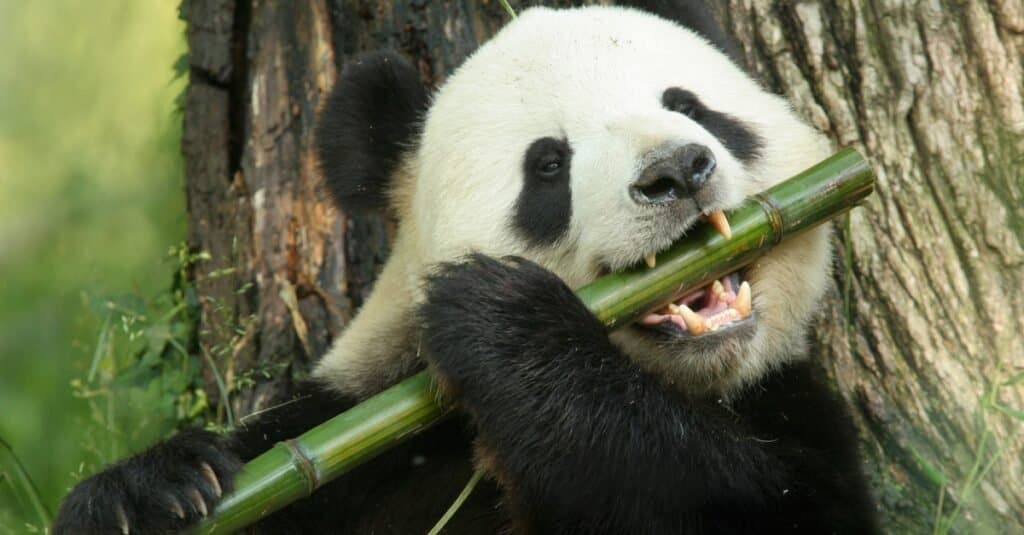
Giant pandas are likely the most famous bamboo eaters. Interestingly, they have evolved to eat meat, too.
©Bryan Faust/Shutterstock.com
Starting with the obvious, the giant panda is one of the most iconic animals on Earth. They have captured the hearts of people everywhere with their lazy attitude, friendly nature, and adorable fuzzy fur. Native to the mountains of central and western China, this incredible bear has an average lifespan of 25-30 years in captivity. They are truly giants, weighing up to an impressive 250 pounds!
Interestingly, giant pandas are technically omnivores, and scientists believe they evolved to eat meat. Still, bamboo makes up 99% of their diets (the other 1% is usually fruit or a bit of meat). The bears can spend up to 16 hours per day chomping on bamboo and can consume around a third of their body weight!
Due to habitat loss and deforestation, giant pandas are critically endangered, with only an estimated 1,800 left in the wild.
Fun fact: All pandas actually belong to China, and the ones found outside of their home country are on loan!
2. Red Panda (Ailurus fulgens)
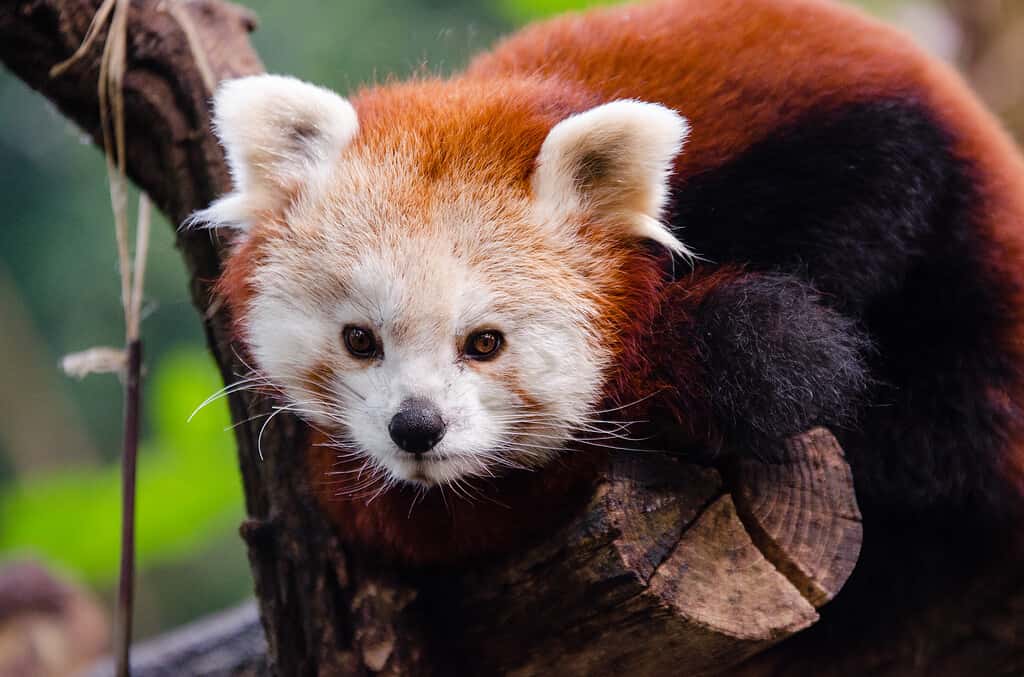
Not a close relative to giant pandas, red pandas also consume lots of bamboo.
©Mathias Appel / CC0 – License
The red panda is an animal we are all familiar with, and is probably one of the most impossibly cute animals in existence. These cat-sized creatures dwell across the Himalayas in very particular bamboo forest habitats at altitudes between 6,000 and 13,000 feet.
Like giant pandas, red pandas also consume bamboo as their primary food source. But they have a more varied diet, also eating leaves, eggs, insects, and even lizards!
There are less than 3,000 remaining in the world and an estimated 10,000 worldwide in zoos and wildlife parks. Despite sharing the same name, these incredible creatures are not closely related to the giant panda. Genome research has shown that they are more closely related to raccoons, weasels, and skunks. Most of the wild red pandas can be found in Nepal and China, although there are small pockets elsewhere in the Himalayas.
Fun fact: Just like giant pandas, red pandas have an extendable wrist bone to help them grip bamboo!
3. Bamboo Rat (Rhizomyinae)

Bamboo rats dig extensive tunnels and eat bamboo roots.
©forest71/Shutterstock.com
The third animal that eats bamboo is less adorable (to say the least) than both panda species. That said, the bamboo rat is an interesting species. They spend most of their time in subterranean burrows, feeding on the roots of bamboo and other species of plant and tree life. Commonly around the size of a small cat, this large rodent can be found across Southeast Asia in four different subspecies.
Bamboo rats are actually hunted for their meat and have been a plentiful food source for people in Southeast Asia for well over 1,000 years. They dig complex warrens under bamboo fields and play a crucial role in aerating the soil and keeping it healthy.
4. Elephants (Loxodonta)
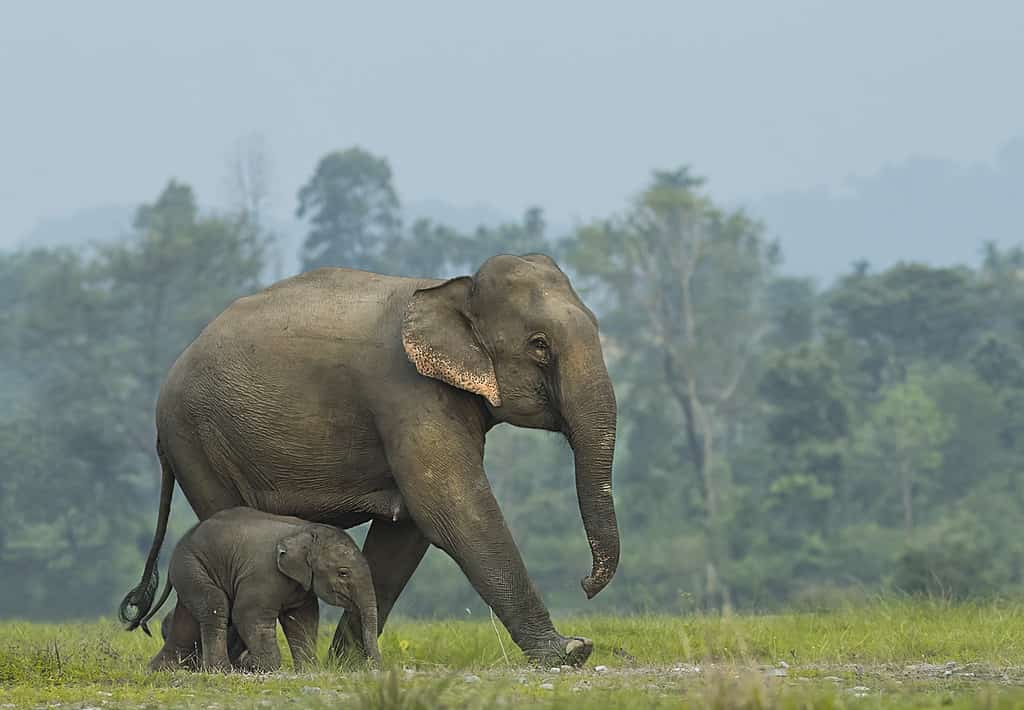
Elephants can eat up to 400 pounds of bamboo and other plants per day!
©saha_avijan/ via Getty Images
This may be one of the most surprising animals on the list for many, but elephants do, in fact, eat a lot of bamboo. As the world’s largest land mammal, it shouldn’t be surprising that these incredible animals eat A LOT! In fact, they spend up to 22 hours daily consuming up to 400 pounds of food!
African elephants have a particular taste for Mai Roak bamboo, and they strip the woody stems of their shoots and leaves.
Elephants can live for more than 70 years and are one of the most intelligent animals in the world (about as smart as a 4-year-old child). They weigh up to 13,000 pounds, and a brain weighing up to 11 pounds. Unfortunately for these gorgeous giants, humans have once again played a major role in their demise, and they are currently listed as endangered.
5. Plains Zebra (Equus quagga)
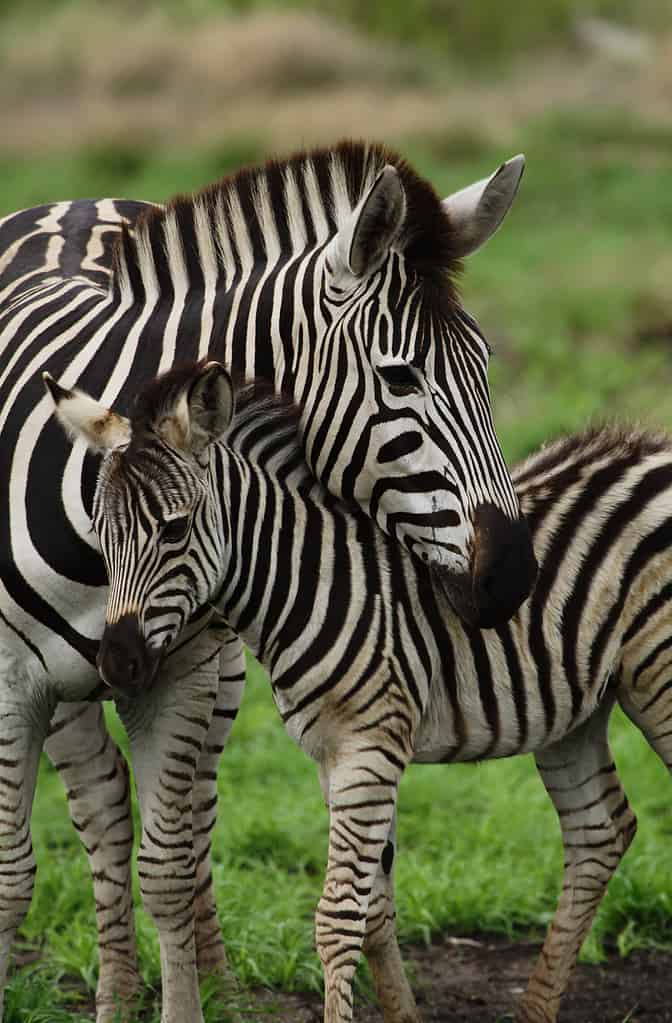
An animal that may occasionally eat bamboo is the Zebra, although they mostly eat other grasses.
©Victor Soares/Shutterstock.com
Another African Icon on the list of bamboo eaters is the eternally fascinating zebra. This striped equestrian creature lives in gigantic herds across the expansive African Plains and consumes mostly grass. They can live 20 to 30 years, and the largest can weigh an impressive 900 pounds! Their stripes are their standout feature and are unique to every individual.
Scientists originally thought that zebra stripes provide camouflage to the zebras until a recent theory suggested that they, in fact, deter flies and regulate their body temperature.
Zebras are in decline and play a key part in the African food chain, as they graze huge areas. They can run at a maximum speed of 40 and are surprisingly agile. While these animals do eat bamboo, it makes up a relatively small part of their diet.
6. Parrot (Psittaciformes)
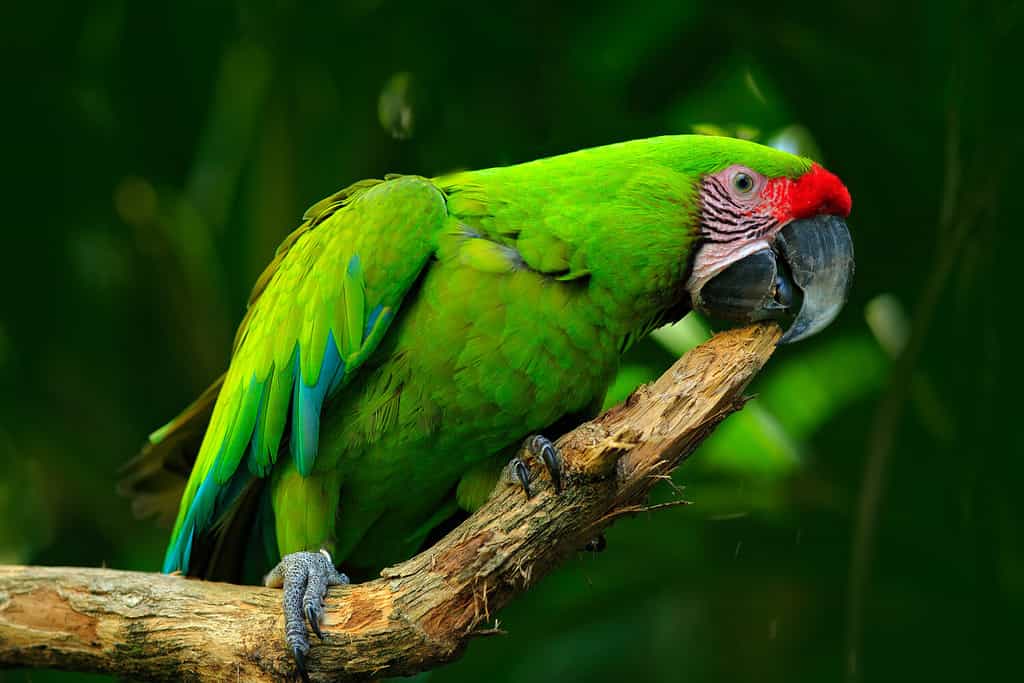
One of the smartest bird species in the world, parrots can live for up to 100 years!
©Ondrej Prosicky/Shutterstock.com
Parrots are surprisingly hardy birds. They primarily live in tropical and warm locations, but they can survive in many places around the world. They are intelligent, make for good pets, and come in a huge variety of colors. There are around 400 identified parrot species in the world!
These enchanting birds are extremely intelligent and have massive lifespans. Some parrots in captivity have even been reported to live up to 100!
They have a varied diet. Parrots will happily eat the fresh shoots of bamboo plants, fruits, nuts, insects, and many other sources of food. They are extremely friendly and social, making excellent pets!
Fun fact: The Largest parrot in the world is the flightless Kakapo native to New Zealand, which can weigh up to 9 pounds!
7. Giraffe (Giraffa)
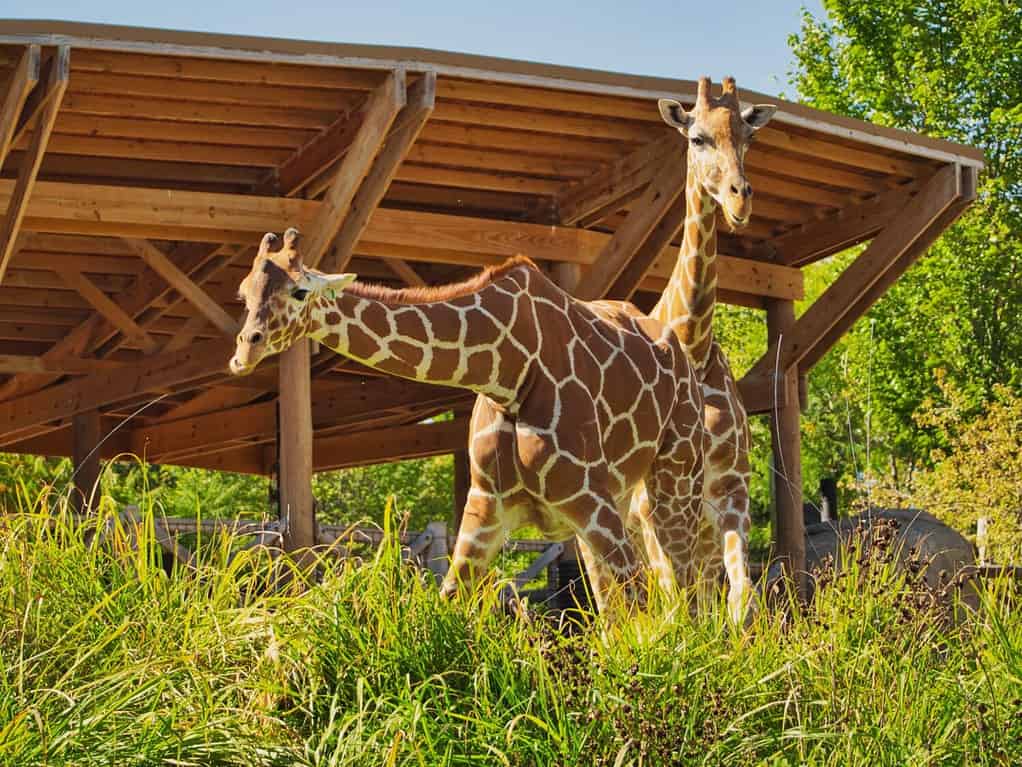
Giraffes eat bamboo, leaves, and other vegetables. They use their unique tongue to strip the lives from the stalks.
©Wirestock Creators/Shutterstock.com
This distinctive mammal is one of nature’s true curiosities with its hoofed feet, horn-like crowns, and incredibly long necks. The giraffe is a majestic and wonderful creature. They have fantastic eyesight and can reach food sources that most other animals can only dream of. Giraffes are herbivores, eating grasses, leaves, and even bamboo.
Always alert, giraffes cannot trot, due to their unique body shape. They go from 0 to a maximum speed of 37 miles per hour in one go, which is quite a sight to behold. Their incredible spotted fur and long limbs help to keep them safe from predators, and they regularly consume 75 pounds of food in a day.
Fun fact: Giraffes can only sleep for 2 hours per day and can actually nap standing up.
8. Guinea Pig (Cavia porcellus)

In South America, guinea pigs are a traditional food source.
©PHOTO FUN/Shutterstock.com
The humble guinea pig is an animal most of us are familiar with. They are domesticated and have been kept as pets for around 3,000 years. They are herbivorous and enjoy the fresh shoots that bamboo plants sprout so regularly, as well as grasses, leafy greens, and leaves. Native to South America, this sociable little rodent thrives on lush mountainous terrain. You may not know that they are traditionally used as a food source, especially in Peru, Ecuador, Colombia, and Bolivia.
They come in many shapes and sizes, although they seldom weigh more than 4.5 pounds, and communicate using a series of complex chirps and squeaks. Despite being referred to as pigs, they are simply rodents and definitely one of the cutest little animals on the list of bamboo lovers!
Fun fact: Guinea pigs very rarely close their eyes to sleep, allowing them to immediately see predators at any time.
9. Bamboo Partridge (Bambusicola)
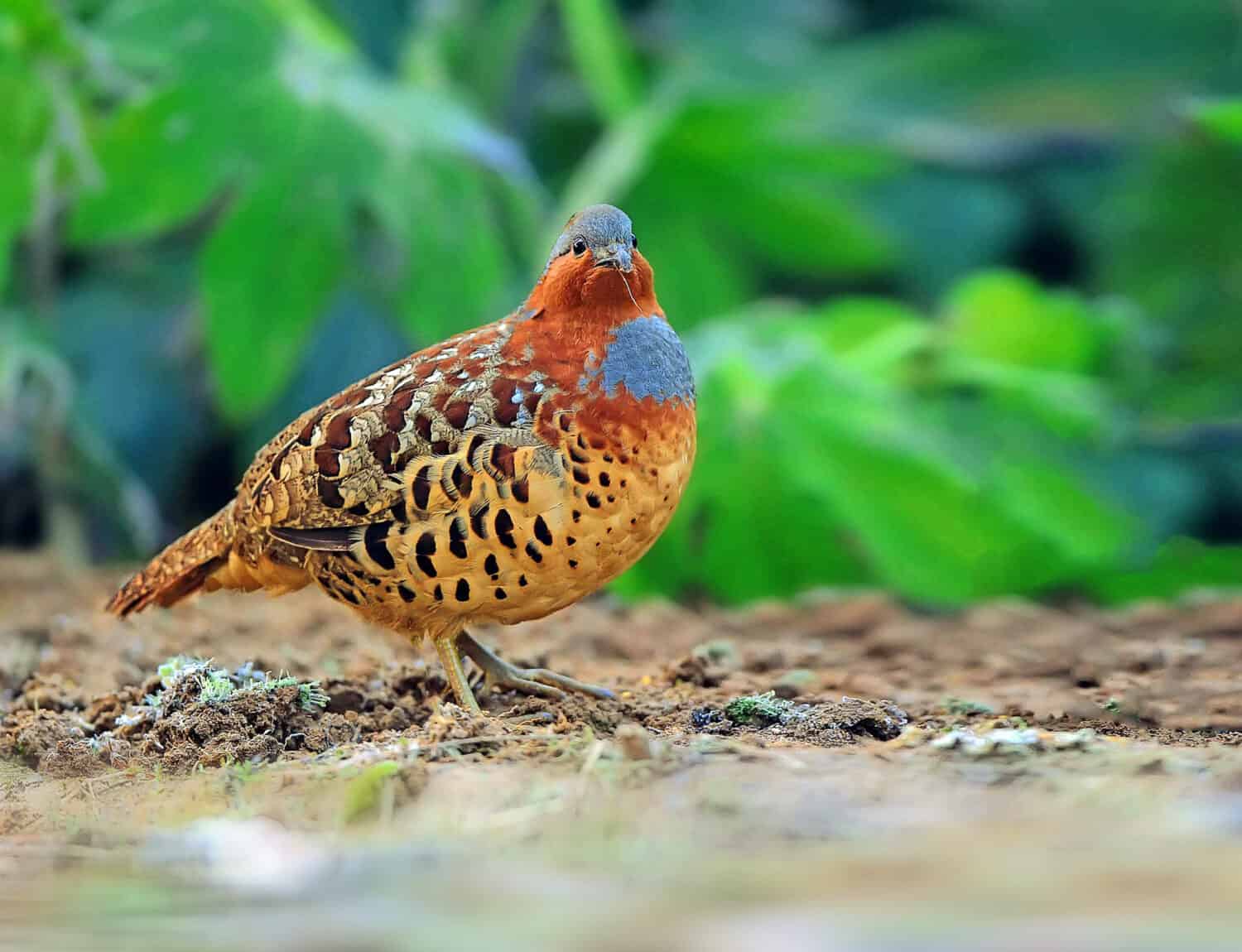
Bamboo partridges live exclusively in bamboo forests in China and Taiwan.
©Wang LiQiang/Shutterstock.com
This beautiful bird has stunning plumage yet is still quite difficult to spot. The bamboo partridge is a member of the extensive partridge family and lives exclusively in bamboo forests, feeding on bamboo shoots, nuts, seeds, berries, and insects.
While it can fly, this little bird rarely flies and weighs only around half a pound! Found predominantly in the dwindling bamboo forests of China and Taiwan, this rare bird is both beautiful and shy. While their population is in decline, the bamboo partridge is not yet labeled as endangered. However, as habitat loss continues, they may become an endangered species.
10. Termite (Isoptera)

Termites can destroy houses, forests, and furniture.
©gunawand3570/Shutterstock.com
Often referred to as the ‘silent destroyers’, termites are viewed as pests by humans, but most of what they do is completely behind the scenes. They live in huge nests that can stand up to 9 meters tall and are architecturally designed to dissipate heat. Additionally, each nest can contain over 100,000 individuals! You can find termites all around the world. Termites feast on a variety of things such as grasses, wood, and even carpet and insulation. These animals will also eat bamboo if it is readily available in their habitat.
The queens can live an incredible 25 years and constantly produce young. These young termites must be constantly fed, hence the damage they are known to do. Interestingly, termites never sleep. From the moment they are born to the moment they die, they work for their colony.
Fun fact: It is estimated that there are around 1,000 pounds of termites for every person on earth!
11. Powderpost Beetle (Lyctinae)

Powderpost beetles form part of 70 species of wood-boring beetles that belong to the subfamily Lyctinae.
©Protasov AN/Shutterstock.com
Sticking with the insect theme, we move on to the powderpost beetle, known as one of the most destructive wood-boring creatures. You can find this species across the planet. It is not picky about the types of wood it eats but prefers moist and fresh wood, making bamboo perfect!
Powderpost beetles are not large, but their ability to reproduce at a rapid speed makes them a pest. They can live anywhere between 6 months and several years, and their distinctive lack of prothorax makes them easily identifiable. Infestations can devastate forests, plantations, houses, and even furniture.
12. Rabbit (Leporidae)
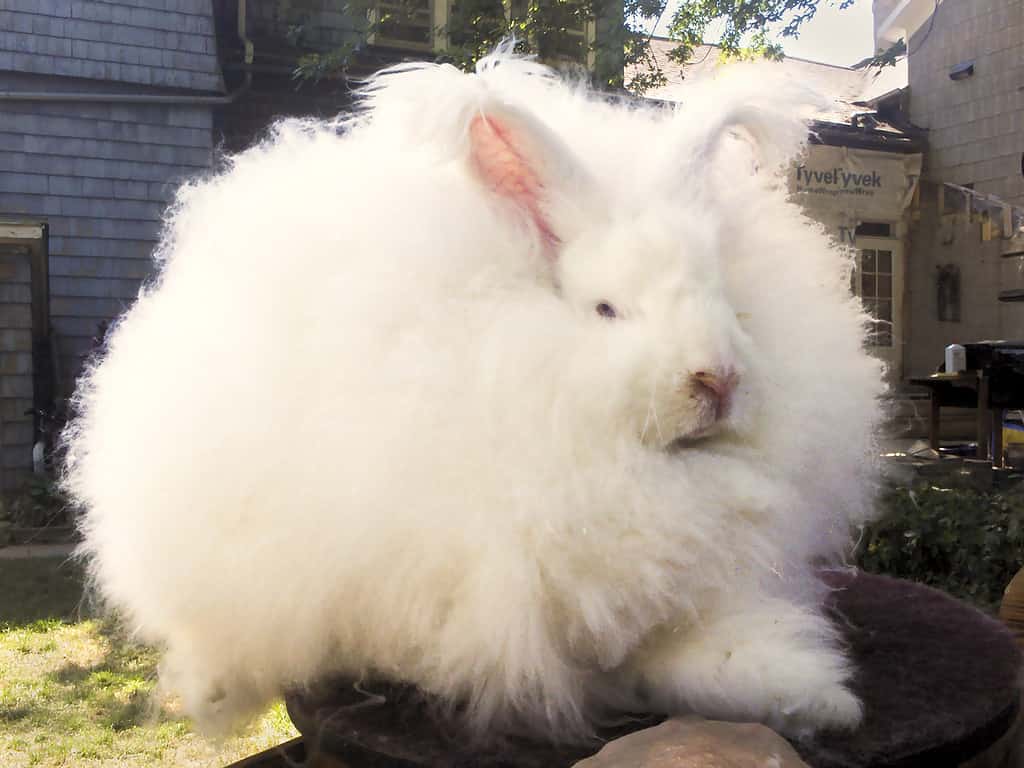
Consuming a wide variety of plants, rabbits may eat bamboo from time to time.
© Devvyn / CC BY-SA 3.0 – License
Rabbits can be found all over the world in huge numbers; anywhere with grass, forest, and soil supportive enough for their warrens, you’ll find rabbits. They can breed incredibly fast and are surprisingly robust survivors, again aiding their incredible numbers.
Rabbits are entirely vegetarian and feed on grass, leafy greens, vegetables, and many other things. Bamboo can offer them important starch and fiber, the green shoots provide great energy, and they have even been known to grind down their teeth with the tough stalks of bamboo. There are many different species of rabbits, but all of them are agile, fast, and alert.
Fun fact: Rabbits have almost 360° vision helping them avoid predators.
13. Chimpanzee (Pan troglodytes)
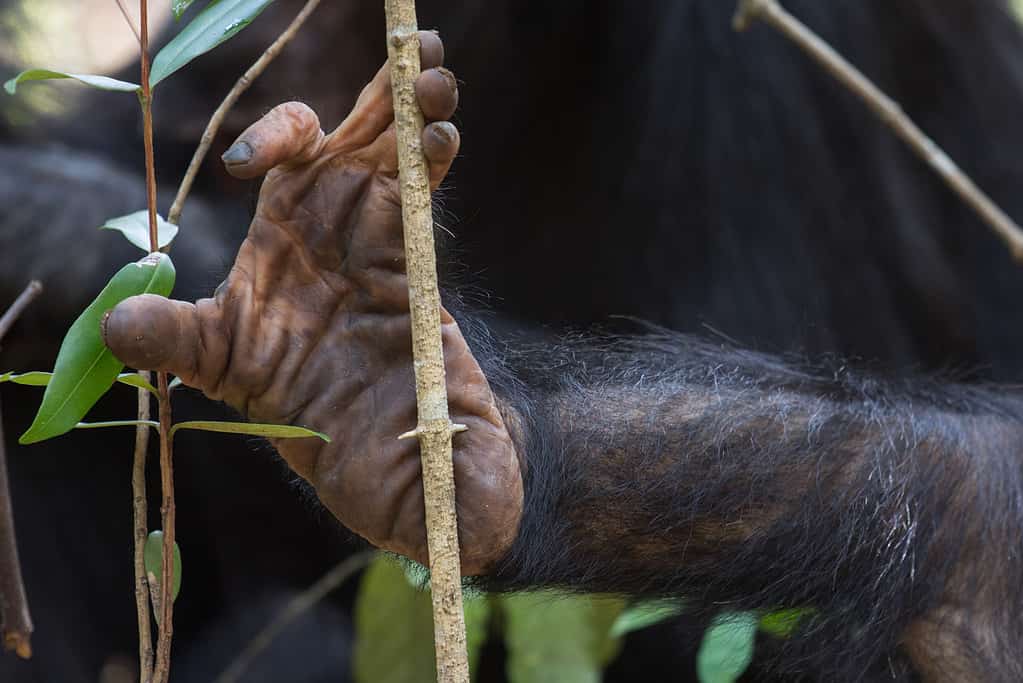
Humans and chimpanzees are very close relatives, though chimps can break down the cyanide in bamboo, and we cannot.
©Steffen Foerster/Shutterstock.com
The chimpanzee can be found in 21 countries across Africa and is one of the most intelligent animals on earth. They can actually learn sign language and communicate with humans, solve complex problems, and even play computer games! Chimps and humans are very closely related, and most scientists believe they are our closest living relatives. That said, while humans cannot consume bamboo, chimps will chow down on the starchy grass.
Their sparse black fur sets them apart from other apes. Part of the great ape family, chimpanzee faces contain recognizable expressions, and their hands are very similar to ours. These incredibly social animals are superb and adaptable animals. They are omnivores that eat hundreds of different types of food, including bamboo, seasonal fruits, insects, seeds, and in some cases, meat. Although meat only makes up 2% of their diet.
Fun fact: Chimpanzees and humans share between 95 and 98% of the same DNA.
14. Golden Snub-Nosed Monkey (Rhinopithecus roxellana)
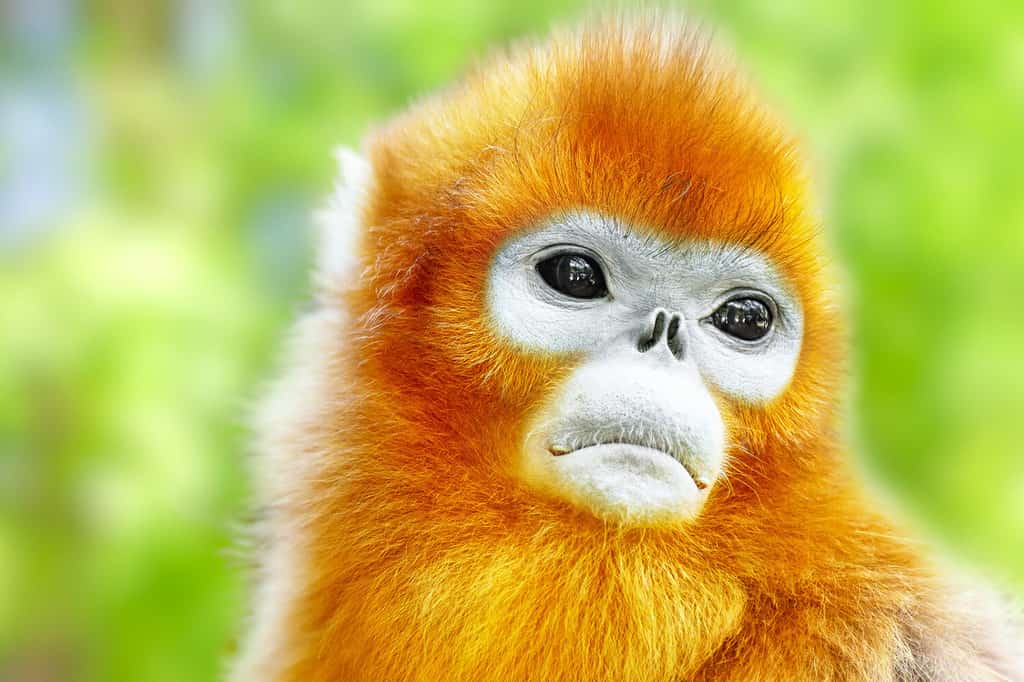
Native to China, the golden snub-nosed monkey feeds on bamboo and other plants.
©V_E/Shutterstock.com
The golden snub-nosed monkey is a truly unique animal that eats bamboo. This monkey’s gorgeous golden and red fur surrounds its white face. They live in mountainous areas of China, and they possess the ability to climb impossibly high trees and traverse their complex landscapes with apparent ease.
Their complex digestive systems have evolved to easily digest fibrous plants like bamboo, but they also gorge themselves on seasonal fruits, barks, and other vegetation. They are mostly herbivores, as they can extract extraordinary energy from a purely vegetarian diet, but they do eat meat sometimes.
15. Bamboo Lemur (Hapalemur)
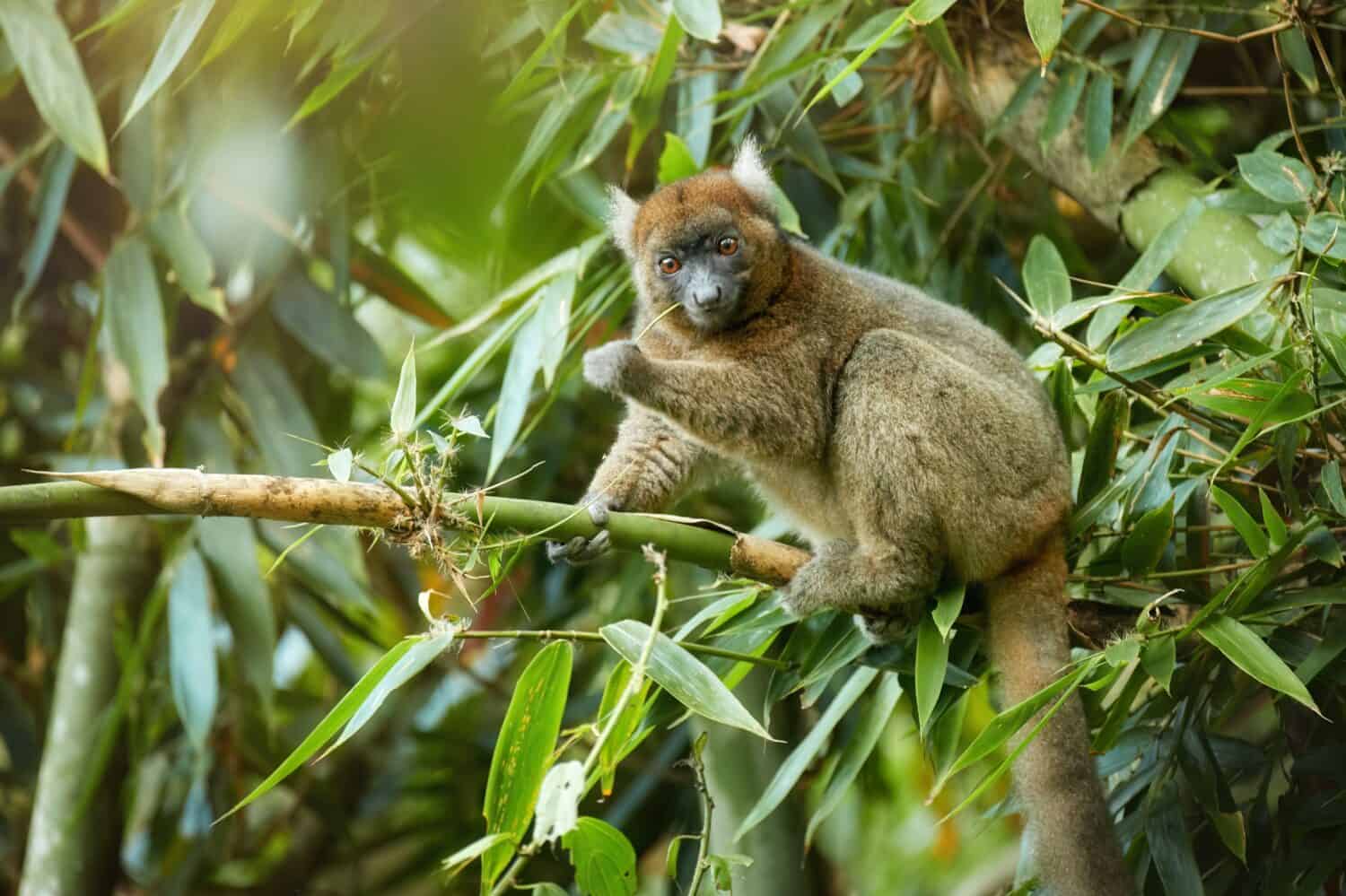
Bamboo lemurs are only in Madagascar and can eat their entire body weight in bamboo per day.
©Martin Mecnarowski/Shutterstock.com
Madagascar is famed for its ethereal and ultra-unique animal and plant life. In fact, 90% of the animals and plants on the island are endemic! The bamboo lemur is one of the most special creatures that call this island home. Lemurs are only found in Madagascar (aside from those in captivity), and we are continually learning new and exciting things about their extraordinary lives.
The bamboo lemur has speckled brown and gray fur and overly large orange eyes. The bamboo lemur has evolved to break down the cyanide in bamboo. In fact, they can weigh 5.5 kilograms and eat their entire body weight in bamboo daily, which makes up 98% of their diets.
Fun fact: Bamboo lemurs were originally known as ‘gentle lemurs’ due to their grace and willingness to interact calmly with humans.
16. Gorilla (Gorilla)

Growing up to 400 pounds, gorillas are the largest primate.
©Tanya Puntti/Shutterstock.com
The gorilla, or ‘King of the Jungle’, is the world’s largest primate and one of the most intelligent creatures. They are commonly portrayed as aggressive and wild, but they are actually timid and more willing to hide than attack.
Sadly, they are a critically endangered species, with populations rapidly depleting. Gorillas are almost entirely vegetarian, eating plants such as bamboo, flowers, roots, and jungle fruits. Despite this, the males are incredibly strong and can weigh more than 400 pounds. They live in small groups and have incredibly complex social structures, often protected by the largest and strongest male gorilla.
Fun fact: It is estimated that the average male gorilla is 4 times stronger than a human male.
17. Bamboo Worm (Omphisa fuscidentalis)

A delicacy in Southeast Asia, bamboo worms are commonly eaten.
©Shcherbyna Nataliia/Shutterstock.com
The bamboo worm is actually not a worm at all. Instead, it is the larvae of a moth belonging to the Crambidea family that lays its eggs exclusively in the soft, inner pulp of bamboo. These worms thrive all across Asia, but most are in Thailand.
The larvae live for around 2 months throughout the summer and remain within the bamboo, constantly feeding for the duration of this stage. Eventually, as they grow to a larger size, they emerge from the bamboo stem to begin the next phase of transformation into a moth.
Summary of the 17 Animals That Eat Bamboo
| Number | Animal | Scientific Name |
|---|---|---|
| 1 | Giant Panda | Ailuropoda melanoleuca |
| 2 | Red Panda | Ailurus fulgens |
| 3 | Bamboo Rat | Rhizomyinae |
| 4 | Elephant | Loxodonta |
| 5 | Plains Zebra | Equus quagga |
| 6 | Parrot | Psittaciformes |
| 7 | Giraffe | Giraffa |
| 8 | Guinea Pig | Cavia porcellus |
| 9 | Bamboo Partridge | Bambusicola |
| 10 | Termite | Isoptera |
| 11 | Powderpost Beetle | Lyctinae |
| 12 | Rabbit | Leporidae |
| 13 | Chimpanzee | Pan troglodytes |
| 14 | Golden Snub-Nosed Monkey | Rhinopithecus roxellana |
| 15 | Bamboo Lemur | Hapalemur |
| 16 | Gorilla | Gorilla |
| 17 | Bamboo Worm | Omphisa fuscidentalis |
The photo featured at the top of this post is © Martin Mecnarowski/Shutterstock.com
Thank you for reading! Have some feedback for us? Contact the AZ Animals editorial team.






